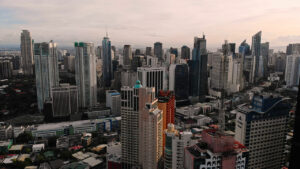Rebirth of Poblacion, Makati

FROM a laid-back community in the 1980s, Barangay Poblacion in Makati City has evolved to become one of the “50 Coolest Neighborhoods in the World,” according to a survey conducted by Time Out, a London-based global travel and hospitality magazine.
During the Spanish era, San Pedro de Macati was founded in 1670 after being carved out from the southern barrios of Santa Ana pueblo in Manila province. Poblacion was the site of its first settlement around the San Pedro Church, which was built by the Jesuit Order in 1620.
When the Jesuits were expelled from Spain and its overseas territories in the late 1700s, the insular government confiscated their Philippine properties that included the Hacienda San Pedro de Macati. This estate was purchased in 1851 by Don Jose Bonifacio Roxas, an ancestor of the Zobel de Ayala-Roxas family.
San Pedro de Macati was incorporated into Rizal province by the American colonial government in 1901. The town was renamed Makati in 1914 by virtue of Philippine Legislature Act No. 2390. Makati’s first municipal building, the Presidencia, opened in 1918 at Poblacion along J.P. Rizal Street fronting the Pasig River. The two-story structure is now occupied by the Museo ng Makati.
Official records showed that the town’s first municipal mayor, Marcelino Magsaysay, came from Poblacion. So did many of his successors, including Maximo Estrella who ordered the construction of a new building called the Municipio in 1961 on another Poblacion property donated by Ayala Corp.
Makati’s real estate boom started in the 1960s when Ayala Avenue became the Wall Street of the Philippines. In 1975, Makati was transferred from Rizal province to a new region called Metro Manila. It attained cityhood status in 1995, which necessitated more office spaces for its growing bureaucracy.
Its first city mayor, Jejomar Binay, thus mandated the construction of the 22-story Makati City Hall at the back of the Municipio in Poblacion. Completed in 2000, it was the country’s first intelligent public building with a computerized automation and management system.
Today, Poblacion serves as Makati’s seat of government and secondary business district next to the Philippines’ financial capital, the Ayala central business district. It is also home to two mixed-used developments (Rockwell Center and Century City), two residential subdivisions (San Miguel Village and Rizal Village), several educational institutions, numerous hotel establishments, and a variety of specialty restaurants.
While retaining its rich cultural heritage, Poblacion has also been a productive venue for business investments. Modern high-rise residential and office buildings are located there, including the country’s tallest condominiums such as Gramercy Residences and Trump Tower Manila.
Ten years ago, Poblacion was known as the Philippines’ Little Korea Town and Metro Manila’s red-light district. Its sleazy reputation began in the 1990s when go-go bars relocated to the area around P. Burgos Street after then Manila Mayor Alfredo Lim drove them away from the Ermita district of the nation’s capital as a result of his anti-prostitution crackdown.
The South Korean “invasion” of Poblacion started in the early 2000s, with the influx of immigrants and transients from Seoul who put up groceries, restaurants, and karaoke bars in the P. Burgos area. In the process, they added an interesting dimension to Poblacion’s evolving demographic.
However, it was only in 2013 when the gentrification of Poblacion began. The catalyst was the opening of a Mexican taqueria called El Chupacabra along Felipe Street near P. Burgos. It was the former commissary of a restaurant chain whose owner decided to come up with a food concept mirroring the vibe of street taco joints in the Mission District of San Francisco, California.
Since then, more upscale restaurants and bars sprouted on the roads surrounding Kalayaan Avenue, where old apartments were converted into hip hostels. By word of mouth, Poblacion was transformed into the hangout for diners craving for varied international cuisine and the enclave for creatives putting up art spaces. This phenomenon peaked in 2019 when the district was on everyone’s bucket list as the preferred entertainment destination.
Most of the pubs and must-eat places closed when the pandemic hit in early 2020. But as soon as restrictions were eased in late 2021, many establishments reopened and new ones replaced those that did not survive the lockdowns. Nowadays, Poblacion is back as the vibrant go-to place for tourists, expats, and Metro Manila denizens alike.
Last month, a new publication titled “POB1210” was launched, featuring the streets and humans of Poblacion. The magazine’s publisher is Tono Verzosa, a scion of the Roces clan, who envisions it to be a public-private partnership with Poblacion’s Barangay Council. As the maiden issue says: “Come to our Poblacion, where Makati never sleeps!”
J. Albert Gamboa is the chief finance officer of Asian Center for Legal Excellence and chair of the FINEX Media Affairs Committee.
#FinexPhils




